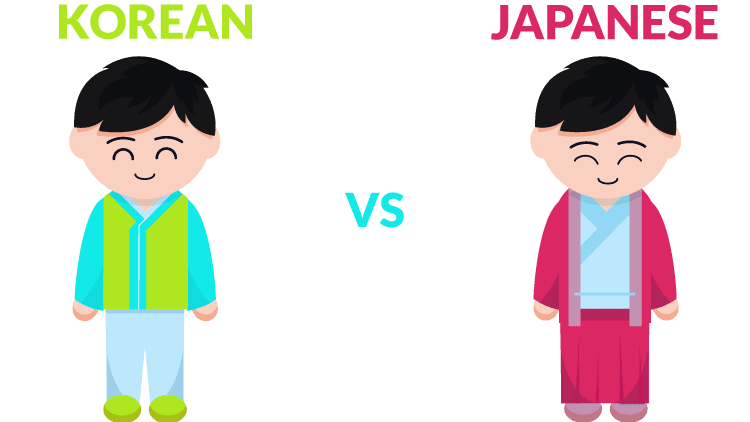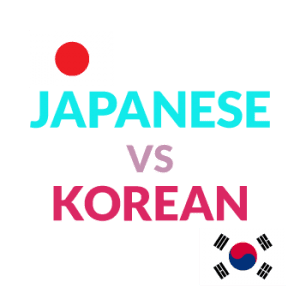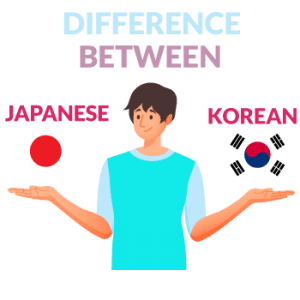
Japanese Vs Korean: Language Differences And Similarities
Both Korean and Japanese are spoken in their respective countries of origin, and both use similar scripts (Hangul in Korea and Kanji in Japan). So if you’re trying to decide which language to study, or you’re just curious about the differences between the two, you’ve come to the right place! Here are some of the most significant similarities and differences between these two East Asian languages.
List of Characteristics
The Japanese and Korean languages are part of an even more prominent language family called Altaic. This language family includes Turkish, Mongolian, and several other languages are spoken by as many as 100 million people.
If you’re planning to learn one or both of these languages, it will help to know what they have in common—and what makes them unique. Both Japanese and Korean are agglutinative languages, meaning that words consist of multiple morphemes. For example, tōkyō comprises three morphemes: to, Kyo, and u. Japanese has three writing systems (called kanji characters), while Korean uses only two (hangeul).
Regarding pronunciation, Japanese has five vowels (or six if you count schwa) compared to Korean’s nine. However, both use pitch accents rather than stress when pronouncing syllables.
Finally, Japanese and Korean share many cognates—words that sound similar in each language but have different meanings. Of course, there are some significant differences between Japanese and Korean. One big difference is that Japanese word order tends to be Subject-Object-Verb, whereas Korean follows Subject-Verb-Object. Another difference is that there are far more irregular verbs in Japanese than in Korean.

The History Of the Japanese Language
Japanese has existed for thousands of years, and its origins are still a source of debate among scholars. One popular theory suggests that Japanese developed from a language called proto-Japonic, which may have been brought to Japan by settlers from what is now southern Korea around 1,000 B.C.
Regardless of its history, it is believed that after developing in isolation for many centuries, Japanese was influenced by Chinese and Korean—the written word was borrowed from Chinese in about A.D. 544—which eventually led to changes in syntax and Japanese grammar; as well as differences in pronunciation, vocabulary, and intonation. Since then, additional influences have helped make Japanese one of Asia’s most unique languages. Japanese is spoken by over 130 million people, primarily in Japan.
It is related to languages such as Ainu and Ryukyuan. However, Japanese is not mutually intelligible with these languages. Japanese has been heavily influenced by other languages throughout its history, including Chinese, Manchu, and European languages like Portuguese and English.
Japanese writing uses three scripts: Kanji (Han characters), Hiragana, and Katakana. These scripts are often used together to form words in everyday use (rather than just hiragana or katakana). In addition to using multiple scripts for words, it’s also common for loanwords (words taken from another language) to be written phonetically rather than using kanji for them as well.
Japanese is a very agglutinative language. This means that instead of using lots of small words, Japanese tends to combine several smaller parts into one word.
For example, instead of saying I don’t have a pen, you’d say no pen. Instead of saying I don’t have any money, you’d say no money. Rather than saying I can’t speak Japanese, you’d say I can’t Japanese. The list goes on! Some linguists think that agglutination may play a role in why Japanese speakers tend to have smaller vocabularies than speakers of many other languages.

The History Of The Korean Language
According to an archaeological study, a group of languages on China’s Yellow River separated around 100 BC. For generations, those people spoke what became known as Old Korean.
When an invader conquered Korea in 108 BC, he forced Old Korean onto his subjects, who picked up many Chinese words as they were forced to adopt writing and other aspects of Chinese culture. This new language was referred to as Middle Korean. The Silla dynasty adopted a more-formalized version of Middle Korean in 668 AD, known today as Classical Korean—the first distinctive form of written and spoken language in Korea still used today.
As a result of increased trade with Japan during its Nara period (710–794), the Japanese took many words from Classical Korean when it began developing its unique language. Around 1500, Korea adopted a writing system based on Hanja (Chinese characters) after officially closing off trade with Japan.
It took nearly two centuries for Koreans to become accustomed to reading and writing using Hanja, but by 1800 most documents had been converted from Hangul (Korean characters). In 1909, Joseon-era King Sunjong abolished Hanja use altogether in favor of Hangul—though older texts are still often written in Hanja for their cultural significance rather than practicality.
Today, South Korea uses only Hangul, while North Korea continues to use both Hangul and Hanja. Japan has also borrowed heavily from Korea since its creation in 538 AD.
Many Japanese words come directly from Classical Korean or later modifications made by Japanese writers during Japan’s Heian period (794–1185). A few examples include dojo (place of training), gakusei (student), bunraku (puppet theater), kabuki (traditional dance-drama), shogun (military governor), and samurai (warrior), among others.
The Differences
One of the most notable differences between Japanese and Korean is that in Japanese, there are two writing systems. You can either use Kanji or Hiragana to write words. While in Korea, only one system called Hangul is used to write words.
Another difference is that Japanese has three different Japanese alphabets (hiragana, katakana, and kanji) while Korean has only one Korean alphabet (Hangul). Another difference between these languages is their grammar structure. For example, the Japanese uses particles like wa and ga while the Koreans use particles like geu, neo, etc. The main difference between Japanese and Korean phonetic alphabets, however, is that Korean can change its sound depending on the phrases or other sounds it’s matched with, meaning it’s not entirely phonetic.
Furthermore, the Japanese use honorifics while Koreans don’t have them at all. Japanese also has more tenses than Korean. Japanese uses past tense, present tense, and future tense, unlike Korean, which only uses the present tense. Moreover, Japanese doesn’t have an equivalent for me, unlike Korean, which does. Both languages share similar grammatical structures, such as passive voice, causative form, and honorific form, although they may differ in conjugation patterns.
Can the Japanese understand Korean?
There are many misconceptions about the relationship between Japanese and Korean people. One common misunderstanding is that Japanese people cannot understand Korean. This is not true. While there are some differences between the two languages, Japanese people are quite capable of understanding Korean.
Is Korean more useful than Japanese?
With the rise of South Korea’s economy and global influence, many people wonder if learning Korean is more valuable than learning Japanese. While both languages have their benefits, Korean may have a slight edge regarding usefulness and demand.
The Similarities
Despite many linguistic differences, there are several similarities between Japanese and Korean. In terms of language history, both languages belong to what is known as a genealogical group called Altaic languages.
This means that both Japanese and Korean are descended from Proto-Altaic, which was spoken by nomadic tribes in Central Asia approximately 5000 years ago. While neither Japanese nor Korean still retains features of Proto-Altaic today, their grammatical structures still have commonalities with other Altaic languages.
For example, Japanese and Korean have agglutinative grammar systems, meaning they use multiple affixes to indicate changes in tense or mood rather than using separate words for each state.
Both also use honorifics (such as san or chan) when speaking formally about others and use classifiers to count objects (for example, saying three glasses instead of just three). Finally, both Japanese and Korean are written using logographic characters; however, each language uses different writing systems (Japanese uses kanji while Korean uses hanja).
The most significant difference between Japanese and Korean? Vocabulary. Although both foreign languages share some vocabulary due to their origins, they’ve diverged significantly over time. Many Japanese people cannot understand anything written in modern Korean and vice versa. Furthermore, certain sounds can be difficult for speakers of one language to replicate if they don’t have experience with them in another context.
For example, Japanese does not distinguish between /l/ and /r/, making it hard for Japanese speakers to say English words like reading or red. Likewise, Koreans often struggle with pronouncing /θ/ and /ð/ sounds because these aren’t used in Korean at all. Another difference is that the Japanese have borrowed many more loanwords from English than the Koreans have. Finally, the Japanese make much greater use of politeness markers such as -san or -sama than the Koreans.

Japanese vs. Korean Grammar
There are many similarities between Japanese and Korean grammar, but there are also some crucial differences. We will take a closer look at Japanese vs. Korean grammar, specifically focusing on three key areas: verb conjugation, word order, and honorifics.
One key difference between Japanese and Korean grammar is verb conjugation. In Japanese, verbs always come at the end of the sentence, regardless of who is doing the action. For example, the sentence “I eat an apple” would be written as “I apple eat.” However, in Korean, the verb always comes at the beginning of the sentence. So, the same sentence in Korean would be written as “I apple eat.”
Another key difference between Japanese and Korean grammar is word order. In Japanese, the basic word order is subject-object-verb, whereas, in Korean, it is subject-object-verb. This means that, in a Japanese sentence, the subject usually comes before the object, but in a Korean sentence, the subject usually comes after the thing. For example, the Japanese sentence “I eat an apple” would be written as “I apple eat,” but the Korean sentence would be written as “I eat an apple.”
Another key difference between Japanese and Korean grammar is honorifics. Honorifics are unique words and phrases used to show respect to someone else. In Japanese, there are many different levels of honorifics, and they are used very frequently.
For example, the sentence “I eat an apple” would be written as “I apple eat” if you were talking to someone of a lower social status than you, but “I apple eat” if you were talking to someone of a higher social status than you. In Korean, there are also different levels of honorifics, but they are not used as frequently as in Japanese. For example, the same sentence in Korean would be written as “I eat apple” regardless of who you are talking to.

Japanese vs. Korean Pronunciation
There are many differences between Japanese and Korean pronunciation, but the three most notable ones are how the two languages handle vowel sounds, consonant sounds, and pitch. While Japan has a relatively simple sound system, Korea has a much more complex one. This can make it difficult for Japanese speakers to learn Korean and vice versa.
One of the most significant differences between Japanese and Korean pronunciation is how the two languages handle vowel sounds. In Japanese, there are only five vowel sounds, while in Korean, there are at least fourteen.
This can make it difficult for Japanese speakers to produce the correct sounds when speaking Korean. The way vowel sounds are lengthened or shortened can also be different between the two languages. In Japanese, vowel sounds are typically increased by doubling them, while in Korean, they are lengthened by adding a unique sound called a yin.
Another difference between Japanese and Korean pronunciation is how the two languages handle consonant sounds. In general, Korean has more consonant sounds than Japanese. The way consonants are pronounced can also be different between the two languages. For example, in Korean, the consonant sound “ㄱ” is pronounced as a hard “g” sound, while in Japanese, it is pronounced as a soft “g” sound. This can make it difficult for Japanese speakers to produce the correct sounds when speaking Korean.
Another notable difference between Japanese and Korean pronunciation is how the two languages handle the pitch. In Korean, the pitch is used to distinguish between different words. For example, the word “사람” (saram) can mean either “person” or “people,” depending on the pitch it is spoken with. This can make it difficult for Japanese speakers to understand Korean, as they are not used to hearing pitch changes within words.
Japanese vs. Korean Vocabulary
There are many similarities between the Japanese and Korean languages, but there are also some significant differences. One key difference is in the vocabulary. While many words are common to both languages, many words are unique to each language.
One area where the two languages differ is in words used to describe family members. In Japanese, there are different words for aunt, uncle, and cousin, depending on whether they are on the mother’s or father’s side of the family. There are also different words for older and younger siblings. In Korean, however, there is only one word for each family member, regardless of their relationship with the speaker.
Another area where the two languages differ is in words used to describe the natural world. In Japanese, there are different words for different types of trees and plants. In Korean, however, there is only one word for every plant.
The two languages also differ in words used to describe emotions. In Japanese, there are different words for different types of happiness, sadness, and anger. In Korean, however, there is only one word for each emotion.
Different Writing Systems
There are many differences between the Japanese and Korean writing systems. The most obvious difference is that the Japanese use a mix of Kanji and Kana, while the Korean uses Hangul. However, there are also differences in the way the two writing systems are used.
One difference between the Japanese and Korean writing systems is their use. In Japanese, Kanji is used for most written communication, while Kana is used for words that are not commonly written in Kanji. In Korean, Hangul is used for most written communication, with Hanja only being used for certain words.
Another difference between the Japanese and Korean writing systems is how they are learned. In Japanese, children learn a mix of Kanji and Kana from a young age. In Korean, children learn Hangul first and then start to learn Hanja in elementary school. People also know about the Spanish to Korean translation.
Another difference between the Japanese and Korean writing systems is how they are written. In Japanese, Kanji is written in columns from top to bottom, while Kana is written in rows from left to the right. In Korean, Hangul is written in blocks, with each block containing a syllable.
Different Sentence Structures
There are many similarities between Japanese and Korean sentence structures, but there are also some crucial differences. In general, Japanese sentences are shorter and more straightforward than Korean sentences, but Korean sentences can be more complex and have more variety.
One key difference between Japanese and Korean sentence structure is that Japanese sentences tend to be shorter. This is because the Japanese rely more heavily on context clues to understand the meaning of a sentence, while Korean is more explicit. For example, a Japanese speaker might say “Tsukue ni pen o” to mean “There’s a pen on the desk,” while a Korean speaker would say “Tsukue-e pen-i iss-eo.”
Another difference between Japanese and Korean sentence structure is that Korean allows for more complex sentences. This is because Korean has a richer vocabulary and more grammatical options than Japanese. Korean sentence structure is more flexible than Japanese sentence structure. This is because Korean has several different sentence patterns that can be used, while Japanese is more limited.
FAQ’S
Is there a big difference between Korean and Japanese?
There are many similarities between Korean and Japanese, such as their writing systems and the fact that both languages use honorifics. However, there are also some significant differences, such as how Korean is spoken in a more formal register than Japanese.
Is Korean more popular than Japanese?
It’s no secret that East Asian culture has taken the world by storm in recent years. Whether it’s K-pop, K-dramas, or fashion, people all over the globe are eager to get a piece of the action. However, Japanese is still more widely spoken overall and is the native language of a far more significant number of people.
